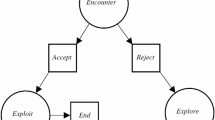Abstract
We describe the development of computational cognitive models that predict information selection behavior in simulated geospatial intelligence tasks. These map-based tasks require users to select layers that visualize different types of intelligence, and to revise probability estimates of attack by hypothetical insurgent groups. Our first model has vast amounts of task-specific declarative memory and selects information layers that provide maximum expected information gain. This first model exhibits layer selection sequences that are almost identical to a rational (Bayesian) model, but fails to predict the layer selection sequences of human participants’ performing the tasks. Our second model integrates instance-based learning with reinforcement learning and information foraging theory to predict the selection of information layers. The second model replicates the distribution of participants’ layer selection sequences well. We conclude with some limitations that our current ACT-R model has and the role of cognitive models in the intelligence analysis tasks.











Similar content being viewed by others
Explore related subjects
Discover the latest articles, news and stories from top researchers in related subjects.References
Anderson JR, Lebiere C (1998) The atomic components of thought. Erlbaum, Mahwah
Anderson JR, Schooler LJ (1991) Reflections of the environment in memory. Psychol Sci 2:396–408
Anderson JR, Bothell D, Byrne MD, Douglass S, Lebiere C, Qin Y (2004) An integrated theory of the mind. Psychol Rev 111:1036–1060
Barto AG (1998) Reinforcement learning: an introduction. MIT press, Cambridge
Betts RK (2007) Two faces of intelligence failure: September 11 and Iraq’s missing WMD. Polit Sci Q 122:585–606
Burns K, Greenwald H, Fine M (2014) Integrated cognitive-neuroscience architectures for understanding sensemaking (ICArUS): phase 1 challenge problem design and test specification (MITRE Technical Report 140410). Retrieved from http://www.mitre.org/sites/default/files/publications/pr_2189-icarus-phase-1-challenge-problem-design-and-test-specification.pdf
Fingar T (2011) Analysis in the US intelligence community: Missions, masters, and methods. Intelligence Analysis: Behavioral and Social Scientific Foundations, pp 3–27
Fu W-T, Gray WD (2006) Suboptimal tradeoffs in information seeking. Cogn Psychol 52:195–242
Fu W-T, Pirolli P (2007) SNIF-ACT: a cognitive model of user navigation on the World Wide Web. Hum-Comput Interact 22:355–412
Fuglede B, Topsoe F (2004) Jensen-Shannon divergence and Hilbert space embedding. In: IEEE international symposium on information theory, pp 31–31
Gibson JJ (1977) The theory of affordances. In: Shaw R, Bransford J (eds) Perceiving, acting, and knowing. Towards an ecological psychology. Wiley, Hobboken
Gonzalez C, Lerch JF, Lebiere C (2003) Instance-based learning in dynamic decision making. Cogn Sci 27:591–635
Heuer RJ (1999) Psychology of intelligence analysis. Center for the Study of Intelligence, Central Intelligence Agency, Washington, DC
Kerr RJ (2008) The track record: CIA analysis from 1950 to 2000 Analyzing intelligence: origins, obstacles, and innovations, pp 35–54
Klein G (1999) Sources of power: how people make decisions. MIT press, Cambridge
Klein G, Moon B, Hoffman RR (2006a) Making sense of sensemaking 1: alternative perspectives. Intell Syst IEEE 21:70–73
Klein G, Moon B, Hoffman RR (2006b) Making sense of sensemaking 2: a macrocognitive model. Intell Syst IEEE 21:88–92
Kullback S, Leibler RA (1951) On information and sufficiency. Ann Math Stat 22:79–86
Lebiere C (1999) The dynamics of cognition: an ACT-R model of cognitive arithmetic. Kognitionswissenschaft 8:5–19
Lebiere C, Pirolli P, Thomson R, Paik J, Rutledge-Taylor M, Staszewski J, Anderson JR (2013) A functional model of sensemaking in a neurocognitive architecture. Comput Intell Neurosci 2013:5
Miller GA (1956) The magic number seven, plus or minus two: some limits on our capacity for processing information. Psychol Rev 63:81–97
Nkambou R, Bourdeau J, Mizoguchi R (2010) Advances in intelligent tutoring systems, vol 308. Springer, New York
Paik J, Pirolli P, Lebiere C, Rutledge-Taylor M (2012) Cognitive biases in a geospatial intelligence analysis task: an ACT-R model. In: 34th annual meeting of the Cognitive Science Society, Sapporo, Japan
Pirolli P (2007) Information foraging theory. In: Adaptive interation with information. Oxford University Press, New York
Pirolli P, Card S (1999) Information foraging. Psychol Rev 106:643
Pirolli P, Card S (2005) The sensemaking process and leverage points for analyst technology as identified through cognitive task analysis. In: International conference on intelligence analysis, McLean, VA, pp 2–4
Puvathingal B, Hantual D (2012) Revisiting the psychology of intelligence analysis: from rational actors to adaptive thinkers. Am Psychol 67:199–210
Roll I, Baker RS, Aleven V, McLaren BM, Koedinger KR (2005) Modeling students’ metacognitive errors in two intelligent tutoring systems. In: User modeling 2005. Springer, New York, pp 367–376
Russell DM, Stefik MJ, Pirolli P, Card SK (1993) The cost structure of sensemaking. In: Proceedings of the INTERACT’93 conference on human factors in computing systems, Amsterdam. ACM, pp 269–276
Simon HA (1974) How big is a chunk? Science 183:482–488
Acknowledgments
This work is supported by the Intelligence Advanced Research Projects Activity (IARPA) via Department of the Interior (DOI) contract number D10PC20021. The U.S. Government is authorized to reproduce and distribute reprints for Governmental purposes notwithstanding any copyright annotation thereon. The views and conclusions contained hereon are those of the authors and should not be interpreted as necessarily representing the official policies or endorsements, either expressed or implied, of IARPA, DOI, or the U.S. Government. We thank Christian Lebiere, Robert Thomson, Matthew Rutledge-Taylor, James Staszewski, and John Anderson for their useful comments.
Author information
Authors and Affiliations
Corresponding author
Rights and permissions
About this article
Cite this article
Paik, J., Pirolli, P. ACT-R models of information foraging in geospatial intelligence tasks. Comput Math Organ Theory 21, 274–295 (2015). https://doi.org/10.1007/s10588-015-9185-x
Published:
Issue Date:
DOI: https://doi.org/10.1007/s10588-015-9185-x




